BY LETTER
World Garden, The
Culture and Society > Fine Arts
Galactography > Sephirotic Empires > Keter Dominion
Galactography > Places and Locales
Galactography > Sephirotic Empires > Keter Dominion
Galactography > Places and Locales
A collection of hundreds of artificial planets with exotic environments | |
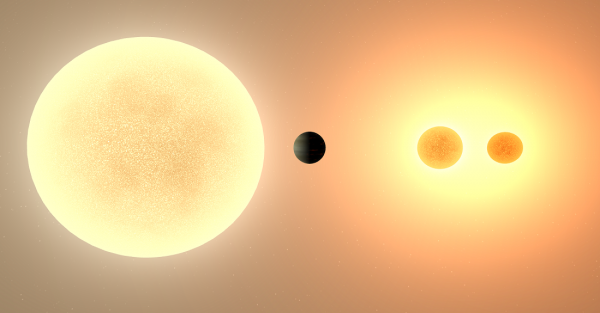 Image from Dangerous Safety | |
| The Rosebud System as it existed when the Gardener arrived. | |
| System | Rosebud |
|---|---|
| Star | JD 813094112 |
| Constellation | Ophiuchus |
| Region | Gardener's Domain |
| Distance from Sol | 3100 ly |
| RA | RA 18H 40 |
| Dec | +7° 23 |
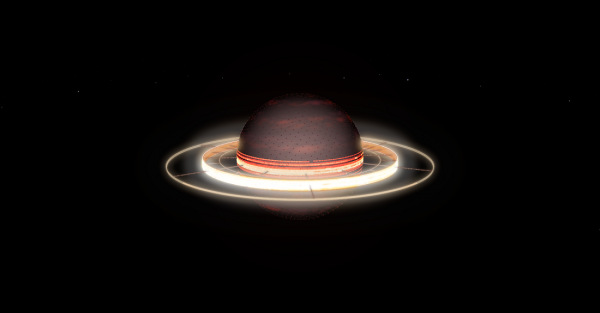 Image from Dangerous Safety | |
| Jasmine, a jovian world in the Rosebud system, now converted to a J-Brain | |
| The Rosebud System: | Quadruple System Age 1.17 gigayears. Rose: Type K8V Star Mass 0.578 x Sol Luminosity 0.0724 x Sol Tulip: Type T8 Brown Dwarf Mass 22.3 x Jupiter Temperature 802 K Orbit 1.88 AU Jasmine: Type AmmoJovian Mesogiant J-brain; Mass 0.635 x Jupiter Orbit 17.7 AU (location of the World Garden) Marigold: Type M7V Star; Mass 0.0913 x Sol Luminosity 0.00064 x Sol Orbit 1170 AU from Rose Lilac: Type L0V Star; Mass 0.0749 x Sol, Luminosity 0.000178 x Sol Orbit 19.4 AU around Marigold. |
|---|
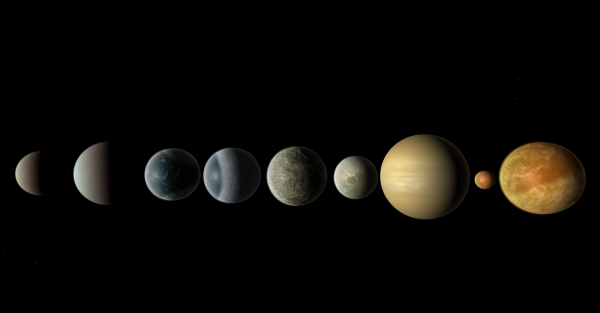 Image from Dangerous Safety | |
| The planets orbiting around Marigold: Lantana, Trillium, Crocus, Lily, Malva, Amaryllis, Daffodil, Gladiolus, and Hyacinth | |
History
The entity that later became the Gardener originated in the territory of the developing Keter Dominion. The star HD 177374, 177ly from Sol in Aquila, had been colonised by a group of independent ahuman transapient-level entities some time before 1800 AT. They appear to have been divergent copies of an original expansionist entity which had emigrated from the Diamond Belt a thousand years before. After 2100 AT, developments in Ain Soph Aur and the rapid ascension of S:3 and S:4 transapients and archailects loyal to the Keter Dominion, appear to have caused some concern to the ahumans in the HD 177374 system. They began to form loose alliances and coalitions for mutual protection.Once the Age of Expansion began in earnest, many of the ahuman entities began to merge together, fearing the growing power of the Keterists. The result of this was a centuries-long power struggle in the system, which often turned violent. The system's subsequent instability caused the neighboring systems to avoid the system. By 2400, through a mix of military and memetic might, a single (unnamed) S:3 had come to dominate the system, with all other high transapients having either left, gone into hiding, or been subsumed.
The S:3 then began converting the system's Jovian into a Jupiter Brain, and breached the fourth singularity in 3044 AT. The unnamed entity drastically changed eir personality during this transcension, becoming an almost entirely different entity: a new archailect that called emself The Gardener. This newly ascended archailect renamed the HD 177374 system, calling it The Plantation. E recreated the few dozen transapients e had previously subsumed, and provided the means to leave the system if they desired to do so.
In 3190 AT, the Gardener sent a small fleet of reactionless drive ships towards the JD 813094112 system which had been observed in the Ophiuchus direction. This fleet carried numerous agents and avatars loyal to the Gardener, hoping to settle the complex star system nearly three thousand light years from The Plantation. The Gardener named this distant group of stars and brown dwarfs the Rosebud System, and hoped to create a new Caretaker God colony there.
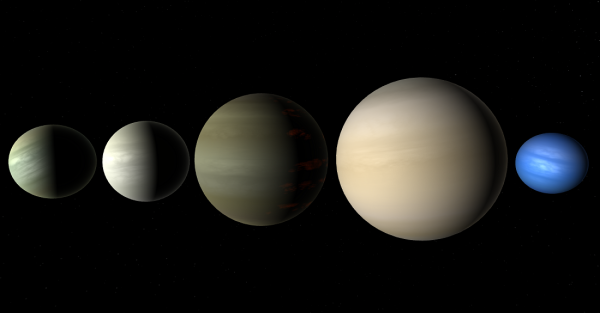 Image from Dangerous Safety | |
| Objects orbiting Rose: Hosta, Daisy, Tulip, Jasmine, Peony | |
In the centuries prior to the Version War, The Gardener created a so-called 'World Garden' surrounding eir Jupiter Brain in the Plantation system. Eight Moon-Brains around the jovian were given fake planetary surfaces each supporting a different alkane of lengths of 30, 18, 12, 8, 5, 3, 2, and 1 in increasing distance from the planet (triacontane to methane). The moons were put in a 30:18:12:8:5:3:2:1 resonance chain to match this.
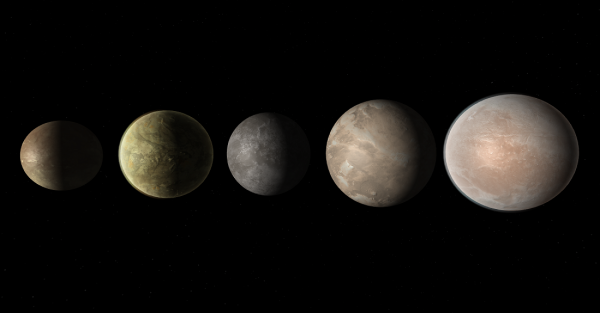 Image from Dangerous Safety | |
| Planet-moons around Tulip: Lady, Parrot, Albion, Triumph, and Emperor | |
The Gardener largely fell into the background after the Version War, having already been surpassed by the S:5s half a millennia prior. E had a few followers and holdings outside of eir system, primarily in the Zoeific Biopolity.
The Gardener's Fleet finally arrived at Rosebud in 7154, and began to develop the stars and other objects in this system into a new, and improved World Garden that would be even more extensive than the one established at the Plantation.
The Rosebud System
Structure
At the center of the Rosebud world garden is Jasmine, a J-brain slightly less massive than Jupiter. This massive intelligent superobject is linked by numerous comm-gauge wormholes to the GodWeb and (indirectly) to the Gardener's original J-Brain back in the Plantation system. This connection appears to have allowed the Gardener to synch eir mentality with the entity inhabiting Jasmine, allowing the two entities to become effectively a single co-ordinated mind. Both entities are generally referred to as The Gardener, although some Godwatchers prefer to call the one in Rosebud 'Jasmine'.Orbiting Jasmine are 816 black hole suprashell worlds in twelve orbital bands, which has been likened to the long-outdated Bohr model of an atom. The innermost and outermost of these bands orbit at distances of 1 and 8 million km from the J-brain. The suprashell worlds within each band share the same mass, with differing radii to allow for surface gravities between 0.01 and 100 gees. More distant bands contain less massive suprashell worlds in greater numbers.
These worlds support environments with various exotic compositions, surface environments, and biochemistries. Most were designed by the Gardener emself, but a number were designed by other, lesser transapients within and beyond the Gardener's Domain.
Illumination is provided to these worlds from a sunring on the J-brain's surface. The temperature and luminosity of this ring is variable, with "sun spots" which follow the worlds as they orbit and provide a customized amount of light to each. The actual star is actually obstructed by a sunshade at the L1 point of Jasmine to allow for colder environments in the world garden. A band of smart lens material surrounds each world to control the distribution of light hitting the surface, as well as mitigate the effects of overlapping sunspots and obscure neighboring worlds from the world's surface if desired.
The Artificial worlds of the World Garden in the Rosebud System
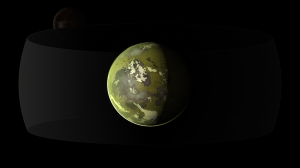 Image from Dangerous Safety | |
| Chartreuse, a fluorogaian world. Also visible is a radiation filter surrounding this world. | |
- - Chartreuse: A Fluorogaian with dull yellow-green seas of hydrofluoric and hydrochloric acid, and grey-brown continents covered with flora and fauna.
- - Tarmac: A world covered by viscous glaciers of asphalt and various long chain hydrocarbons, with a nearly flat surface only broken up by the occasional carbide rich mountain or river of oil and paraffins. It hosts an appreciable biomass of microorganisms in its tarry substrate.
- - Bloom: A world with a 1050 K global ocean of NaCl and other alkali halides under a sulfur atmosphere. Its dull orange seas are filled with colorful algae-like blooms visible from orbit. These metabolize extremely quickly, and continent sized swaths of color with appear, move, change shape, and disappear from the surface over the course of a few hours.
- - Powerhouse: A metal-rich ferrinian with a very simplistic, but large scale mechanosystem, reminiscent of industrial age factories and the earliest neummans with a distinctly mechanical appearance.
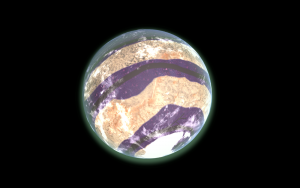 Image from Everything4404 | |
| Spiral | |
- - Spiral: A ammonia-rich gaian world with a single river-like sea that spirals around the planet from pole to pole. The long length allows the polar ends of the sea to have very different compositions, with the north pole being cyanide rich and the south pole being formamide rich, with a long gradient between the two.
- - Triple Shot: an ocean world with three concentric layers of fluid, separated by organic mats; the lowest is carbon tetrachloride, the middle is water, the top layer is hexane.
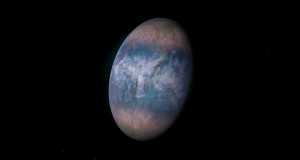 Image from Steve Bowers | |
| Prolate, a world with a bulge at each pole | |
- - Prolate: A highly prolate version of a post-gaian world, with a nearly cylindrical appearance. Near the equator, gravity is 1 gee, which drops to 0.1 gee at the poles. The poles are nearly free of atmosphere.
- - Improbable: A barren nitrogen rich world lacking oxygen and carbon. Various grey and brown nitride minerals make up the surface, and a thin nitrogen atmosphere to blow dust around.
- - Open Cycle: A hot lacustrine world, with 1200 K lakes of beryllium and lithium fluoride. Trace amounts of dissolved uranium, thorium, and plutonium fluorides in the lakes slowly undergo fission at a controlled rate.
- - Super Hot: A 3800 K world with a semi-molten carbon ocean with diamondoid mineral life.
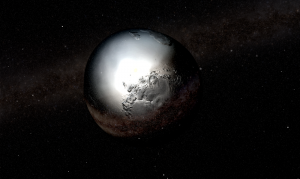 Image from Steve Bowers | |
| Mirror, an artificial world with seas of liquid mercury, lakes of gallium and a solid, metallic continental crust | |
- - Mirror: A world with an ocean of mercury, with various metal landmasses floating on the surface which react to various degrees and partially amalgamating with the mercury below. On these metal continents are lakes of gallium, which can become partially covered by gallium ice in colder regions.
- - Decay: A world made of promethium and technetium, which decay over time. The promethium decays into neodymium and samarium over time, which make up 1600 K oceans. Less stable isotopes of technetium decay into molybdenum and ruthenium, which together are the primary minerals in the planet's crust.
- - Fizzle: A world covered by vast green-white deserts of plutonium, samarium, and gadolinium chlorides, with a chlorine and xenon atmosphere. The plutonium chloride sand is concentrated over time by wind until critical mass is reached, creating a small kT fizzle scattering the plutonium sand. These explosions occur roughly once every few minutes.
- - Carbonyl: A world with a iron and nickel carbonyl seas, rusted metal continents, and a metal rich biosphere.
- - Cooler: A world with a low temperature biosphere in 20 K liquid hydrogen seas.
- - Syrup: A 180 K world with a golden-brown viscous hydrocarbon and borane ocean host to an organoboron biosphere.
- - Current: A dimly lit high-gravity world with an electrically charged atmosphere. With a spectacular global aurora in its thin helium, neon, argon, krypton, oxygen and nitrogen atmosphere. The icy white surface below provides contrast to the light show above.
- - Beach ball: A world with several tall mountain ranges partitioning the tropical planet into strips running north to south. Each strip hosts a different color of flora and plankton, giving a unique striped appearance.
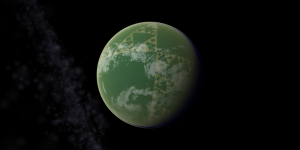 Image from The Astronomer | |
| Sierpinski, with its distinctive triangular landforms | |
- - Sierpinski: A world with an octohedral arrangment of alternating triangular oceans of hydrogen cyanide and Sierpinski triangle landmasses. There are numerous imperfections from topographical features such as mountains, lakes, island chains, and rivers giving a wild and unmaintained look to the normally self similar fractal.
- - Foam: A world covered by a shallow ocean filled with a large amount of prebiotic organic compounds and microorganisms with a total biomass being nearly 5% that of the ocean's mass. High winds agitate the ocean, creating large swaths of an almost soapy seafoam which cover large portions of the world.
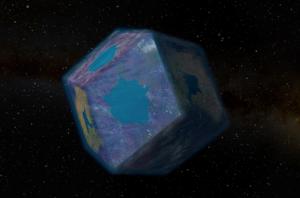 Image from Steve Bowers | |
| Rhombohedron has an exotic maroon biota on its rhomboid surfaces | |
- - Rhombohedron: a polyhedral (rhombic dodecahehral) world, with an array of miniature black holes inside that causes gravity to be normal to the surface (except near the edges of each face)
- - Shallow: A flat sandy world with elevations varying by only a few meters from the highest to lowest point. It is covered by a roughly 50 cm deep ocean. Tides from other objects in the garden are sufficient to cause sandbars to appear and disappear under the sea seemingly at random.
- - Turbulence: A cloud covered cytherean world with differently colored clouds with chaotically mix in large storms, underneath which is a thriving supercritical carbon dioxide biosphere.
- - Glitter: A world covered with a fine blend of diamond dust intermixed with quartz and silver, creating a shimmering world as these dusts are blown around in the inert atmosphere
Tourism
Tourism of the World Garden is often done remotely, as the exotic biochemistries and geochemistries can be sensitive to non-native residents and vice versa. There are some exceptions for more mundane worlds. For the most extreme worlds, distance observations and virches portraying the environment in real time are the only ways to experience the surface.Appears in Topics
Development Notes
Text by Dangerous Safety (2020)
Amending the original article 'The Gardener's Domain' by Anders Sandberg Additional material by Sandcastles, MichaelPoole, Everything4404, Steve Bowers
Initially published on 01 November 2001.
Amending the original article 'The Gardener's Domain' by Anders Sandberg Additional material by Sandcastles, MichaelPoole, Everything4404, Steve Bowers
Initially published on 01 November 2001.






